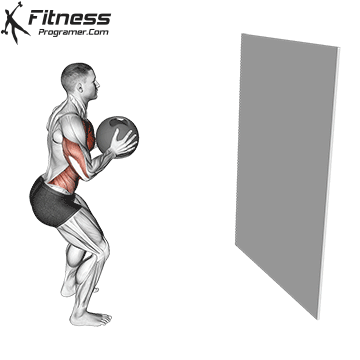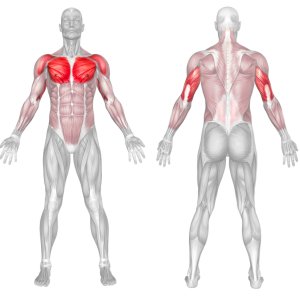Standing Medicine Ball Chest Pass
The Medicine Ball Chest Pass is a plyometric exercise that involves explosive upper body movements, particularly targeting the chest, shoulders, and triceps muscles. It’s commonly used in sports like basketball, volleyball, and athletics, where generating force rapidly is important. In addition to sports-specific training, it can be a valuable component of general strength training and functional workouts.
How to do:

- Setup:
- Stand with your feet shoulder-width apart.
- Hold the medicine ball with both hands at chest level, elbows bent and pointing outward.
- Position the ball close to your chest, maintaining a firm grip.
- Execution:
- Begin by bracing your core and engaging your lower body muscles.
- Push the ball forcefully away from your chest using both hands simultaneously.
- As you extend your arms, fully extend your elbows but do not lock them out.
- The goal is to release the ball in a controlled manner, propelling it forward explosively.
- Follow through with your arm movement, and make sure your wrists stay straight during the entire motion.
- Reception:
- As the ball travels away from you, quickly bring your hands back to your chest.
- Prepare to catch the ball as it rebounds back toward you.
- Catch the ball before it hits the ground, absorb the impact by bending your elbows slightly and flexing your shoulders.
- Repeat:
- After catching the ball, reset your starting position and repeat the movement for the desired number of repetitions.
Tips:
- Always warm up before performing explosive exercises to prepare your muscles and joints.
- Keep your core engaged throughout the exercise to maintain stability and prevent excess strain on your lower back.
- Use a medicine ball that’s appropriate for your fitness level and goals. The weight of the ball will affect the intensity of the exercise.
- Focus on explosive power and coordination rather than using excessive weights.
- Ensure you have adequate space in front of you to safely perform the exercise without obstacles.
Medicine Ball Chest Pass – Benefits
Explosive Power: The Medicine Ball Chest Pass involves an explosive movement where you generate force through your chest, shoulders, and triceps to throw the medicine ball with maximum power. As you forcefully push the medicine ball away from your chest, your muscles undergo a quick stretch-shortening cycle. This cycle stores and releases elastic energy, resulting in greater explosive power production. This explosive power is essential for sports activities like throwing, hitting, and jumping.
Upper Body Power and Strength: The Medicine Ball Chest Pass can be categorized as both a strength and power exercise due to its explosive nature. The exercise primarily targets the muscles of the chest, shoulders, and triceps. As you explosively push the medicine ball away, these muscles contract forcefully, leading to increased upper body power and strength.
Functional Movement: The movement pattern closely mimics actions seen in various sports, such as basketball, volleyball, and tennis. It helps improve functional strength and coordination specific to these activities.
Cardiovascular Benefits: The explosive nature of the exercise can increase heart rate and provide a cardiovascular benefit when performed in a circuit or high-intensity interval training (HIIT) format.
Core Engagement: To stabilize your body while performing the chest pass, your core muscles must engage to maintain proper posture and balance. This exercise thus contributes to core strength and stability.
The Standing Medicine Ball Chest Pass can be incorporated into various workout routines, including full-body strength training, power-focused workouts, or sports-specific training. If you’re new to this exercise, consider seeking guidance from a fitness professional to ensure you’re performing it safely and effectively.
Medicine Ball Chest Pass Muscles Worked
- Chest (pectoral muscles)
- Shoulders (deltoid muscles)
- Triceps
- Core muscles
- Upper Back

